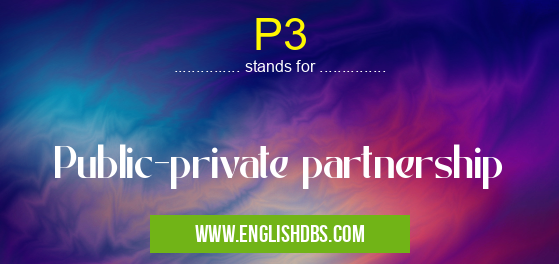What does P3 mean in EMPLOYMENT
Public-private partnership (P3) is a form of collaboration between the public sector and the private sector, where the latter undertakes the financing, construction, and operation of public infrastructure assets, with the goal of improving the efficiency and effectiveness of service delivery. This partnership model has emerged as a solution to address the increasing infrastructure needs amid budget constraints and limited public funding.

P3 meaning in Employment in Governmental
P3 mostly used in an acronym Employment in Category Governmental that means Public-private partnership
Shorthand: P3,
Full Form: Public-private partnership
For more information of "Public-private partnership", see the section below.
P3 Meaning in Government
In government, P3s are instrumental in developing and managing various infrastructure projects, such as roads, bridges, hospitals, schools, and energy facilities. The public sector provides the legal and regulatory framework, while the private sector brings in expertise, funding, and operational capabilities. By leveraging the strengths of both sectors, P3s aim to deliver high-quality infrastructure that meets the needs of the public.
P3 Full Form
The full form of P3 is "Public-Private Partnership." This partnership model typically involves three key parties: the government, a private sector consortium, and users or beneficiaries of the infrastructure asset.
What Does P3 Stand For
P3 stands for Public-Private Partnership, which signifies:
- Public: The involvement of the government or public sector in the project.
- Private: The participation of the private sector, which includes corporations, investment firms, and other entities.
- Partnership: The collaborative nature of the arrangement, where the public and private sectors work together towards a common goal.
Benefits of P3s
- Increased Efficiency: P3s streamline project execution by combining the expertise of both the public and private sectors.
- Cost Optimization: Private sector involvement often leads to cost reduction and efficient use of resources.
- Innovation and Technology: P3s encourage the adoption of innovative technologies and construction methods.
- Risk Sharing: The risks associated with the project are shared between the public and private partners, reducing the burden on either party.
- Improved Service Delivery: P3s focus on delivering high-quality infrastructure and services that meet the specific needs of the public.
Essential Questions and Answers on Public-private partnership in "GOVERNMENTAL»EMPLOYMENT"
What is a Public-Private Partnership (P3)?
A Public-Private Partnership (P3) is a long-term contractual agreement between a government entity and a private sector partner to deliver a public infrastructure project or service.
What are the benefits of P3s?
P3s offer several potential benefits, including:
- Access to private sector expertise and innovation
- Risk sharing between the public and private sectors
- Reduced project costs and timeframes
- Improved project quality and efficiency
What are the risks associated with P3s?
P3s also carry certain risks, such as:
- Potential for increased costs over the long term
- Loss of government control over the project or service
- Limited public accountability and transparency
How are P3s structured?
P3s can be structured in various ways, such as:
- Design-build-finance-operate (DBFO) contracts: The private partner designs, builds, finances, and operates the project.
- Design-build-operate-maintain (DBOM) contracts: The private partner designs, builds, operates, and maintains the project.
- Public-private infrastructure partnerships (PIPs): The private partner manages and operates the project but does not have full ownership.
What are some examples of successful P3s?
Some notable examples of successful P3s include:
- The M25 orbital motorway in the United Kingdom
- The Port of Miami Tunnel in the United States
- The Ottawa Light Rail Transit system in Canada
Final Words: P3s have become an integral part of infrastructure development in many countries. By fostering collaboration between the public and private sectors, P3s leverage the strengths of both parties to deliver efficient, cost-effective, and innovative infrastructure that enhances public services and benefits society as a whole.
P3 also stands for: |
|
| All stands for P3 |
